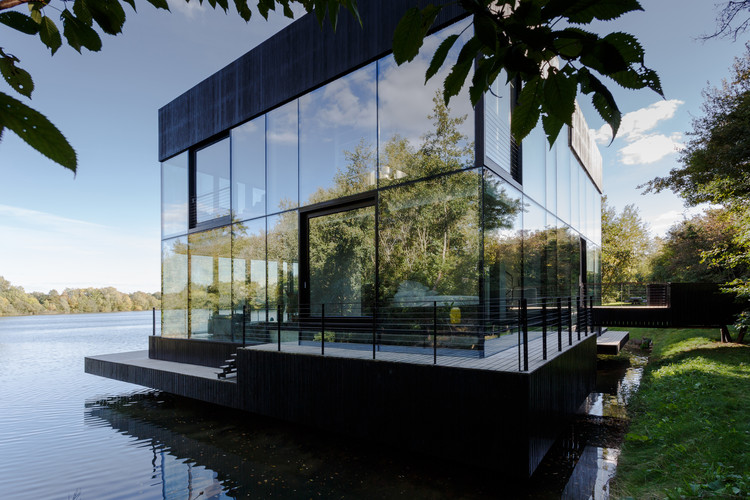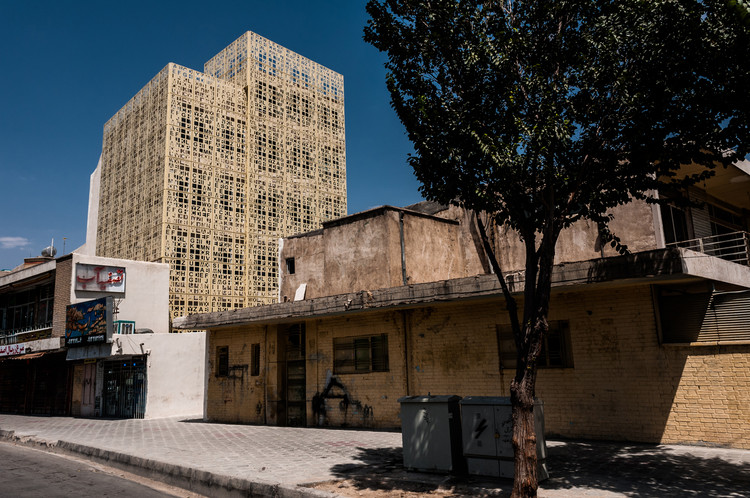Parking Attendant’s Pavilion Jean
2011-09-05 00:00
架构师提供的文本描述。停车场位于市中心外,周围是一片郁郁葱葱的景观,将建筑物隔离起来,在平坦的停车场上可以看到它。原来的停车方案的出现迫使我们在入口处拥挤的人行道上进行设计。这些条件促使我们关注项目作为一个符号的价值以及它的形态自主性。
Text description provided by the architects. The parking lot is situated outside of the city center, surrounded by a lush landscape, placing the building in isolation where it is highly visible against the flat parking lot. The presence of the original parking program forced us to design on a cramped area of pavement at the entrance. These conditions prompted us to focus on the value of the project as a symbol as well as its morphological autonomy.
在项目衍生的环境以及周边景观的驱动下,我们研究了小木屋的概念。从概念到建筑,该项目展示了一种真正的可持续建筑方法,即从当地工业获得并由当地劳动力执行的自然和环境友好型材料。
Driven by the environmental context from which the project is derived as well as the surrounding landscape, we looked at the concept of a cabin. From concept to construction, the project demonstrates a real approach to sustainable architecture with natural and environmentally friendly materials from local industry that were acquired from nearby businesses and carried out by local labor.
目标简单:控制出入口,引导车辆,确保整个停车场的清晰视野,同时为公众提供一个欢迎和信息的空间。展馆的建筑表现在控制与欢迎公众的矛盾中,形成了朴素的建筑之间的二元性,形成了必要的控制机制,同时也意识到了营造欢迎的公共氛围所必需的东西。
The objective is simple: control the entrance and exit, guide the vehicles, ensure a clear view of the entire parking lot, all while offering the public a welcoming and informational space. The architectural expression of the pavilion was found in the contradiction between controlling and welcoming the public, forming a duality between a plain building that groups the necessary mechanisms for control, while realizing that which is also necessary to create a welcoming public atmosphere.
为了在围栏和停车场之间的地块上创造一个形象,我们必须先找到自己的位置,并从原来建筑的痕迹及其限制中获利。在规划中,建筑物与道路和栅栏平行运行,尊重场地的现有指南。它开始在坡度处扭动,使接待处朝行人通道方向移动。其目的是通过一个简单而清晰的视觉环境,加强建筑物面向公众的开放。这种扭曲严重影响了该项目,实现了控制和欢迎公众之间的方案紧张关系,导致了双曲线抛物面形状。
To create a presence on the plot between a fence and the parking lot, we had to start by finding our place and a way to profit from the traces of the original building and its restrictions. In plan, the building respects the existing guides of the site by running parallel to the road and the fence. It begins to twist at grade to direct the reception area towards the pedestrian walkway. The goal was to reinforce the opening of the building towards the public through a simple and clear visual context. The twist heavily influenced the project by materializing the programmatic tension between controlling and welcoming the public, resulting in a hyperbolic paraboloid shape.
一个较低的角落允许屋顶突出在入口,创造了一个独特的斜坡。表面上简单的几何形式隐藏了游戏的动态性,影响了人们对建筑物的感知方式,并使其难以理解。这种扭曲试图与环绕它的环流中的通量一起进行。正是在这种简单的扭曲中,产生了一个复杂的形状,实现了项目的目标:一个离散而又有趣的当代形态,出现在其感知方式的多样性中。
A single lowered corner permits the projection of the roofline over the entrance, creating a unique slope. The apparently simple geometric form hides the kinetic game at play, influencing the way in which one perceives the building and making it difficult to understand. The contortion attempts to go along with the flux in circulation that surrounds it. It is in this simple distortion that a complex shape is generated, achieving the project’s objective: a discrete yet intriguing contemporary form found in the diversity of its perceptive approaches.
我们选择了一个L形的方案,它优化了服务员对停车场的看法,每个立面上都有开口。布局创建了一个既开放又受保护的大区域。一个天篷,在夜间照明,加强了结构和它的程序在天黑后的存在。这一空间将公共服务组合和庇护,使所有便利设施(如洗手间和服务员办公室)都能方便地进入,而外部服务装置(自动售票机、废物贮器、报机、警报、气候控制和照明)则被整合到墙上。
We chose an L shaped plan that optimizes the attendant’s view of the parking lot with openings on every facade. The layout creates a large area that is both open and protected. A canopy which is lit at night reinforces the presence of the structure and its program after dark. This space assembles and shelters the group of public services in such a way that all of the amenities (such as the restroom and attendants office) are easily accessible, while the exterior service fixtures (automated ticket machine, waste receptacle, newspaper dispenser, alarm, climate control and lighting) are integrated into the wall.
包封系统在热损失和安全方面保证了玻璃的保护。它的功能就像晴雨表,有助于通风,满足夏季的舒适需求。在内部,包层是由烘焙胶合板组成。这种材料是以沿结构定义的几何形状水平放置的条带的形式使用的。背光聚碳酸酯肺泡板为天花板叠层地板,和一种天然树脂完成了内部材料的对比,与粗糙的外部包络。
The envelope system ensures the protection of the glazing in terms of thermal heat loss and security. It functions as a brise-soleil and helps with the ventilation, addressing the need for comfort during summer months. Inside, the cladding is composed of bakelised plywood. This material is used in the form of strips placed horizontally along the geometry defined by the structure. Backlit polycarbonate alveolar panels for the ceiling laminated flooring, and a natural resin complete the interior materials used to contrast with the rough exterior envelope.
 举报
举报
别默默的看了,快登录帮我评论一下吧!:)
注册
登录
更多评论
相关文章
-

描边风设计中,最容易犯的8种问题分析
2018年走过了四分之一,LOGO设计趋势也清晰了LOGO设计
-

描边风设计中,最容易犯的8种问题分析
2018年走过了四分之一,LOGO设计趋势也清晰了LOGO设计
-

描边风设计中,最容易犯的8种问题分析
2018年走过了四分之一,LOGO设计趋势也清晰了LOGO设计






































































































